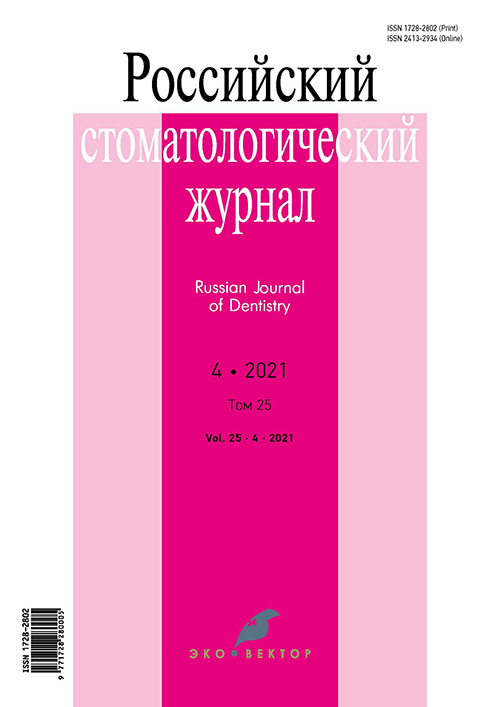Application of laser technologies in patients with flat red oral mucosa
- Authors: Tarasenko S.V.1, Stepanov M.A.1, Kalinin S.A.1, Morozova V.V.1
-
Affiliations:
- I.M. Sechenov First Moscow State Medical University (Sechenov University)
- Issue: Vol 25, No 4 (2021)
- Pages: 359-369
- Section: Reviews
- Submitted: 26.06.2022
- Accepted: 26.06.2022
- Published: 15.07.2021
- URL: https://rjdentistry.com/1728-2802/article/view/109010
- DOI: https://doi.org/10.17816/1728-2802-2021-25-4-359-369
- ID: 109010
Cite item
Abstract
This study reviews evidence on the diagnosis and treatment of lichen planus in the oral mucosa, and also evaluates the effectiveness of using erbium and neodymium lasers and scalpels for the surgical treatment of patients diagnosed with the same. Previous clinical and biomedical studies found that laser technologies offered several advantages over traditional scalpel treatment, including less tissue trauma, selective effects on the lesion, more favorable postoperative outcomes, and a shorter rehabilitation period. These factors, in turn, contributed to an increase in the efficiency of surgical treatment and a reduction in the likelihood of recurrence and postoperative complications.
Full Text
About the authors
Svetlana V. Tarasenko
I.M. Sechenov First Moscow State Medical University (Sechenov University)
Author for correspondence.
Email: prof_tarasenko@rambler.ru
ORCID iD: 0000-0001-8595-8864
MD, Dr. Sci. (Med.), Professor
Russian Federation, MoscowMichail A. Stepanov
I.M. Sechenov First Moscow State Medical University (Sechenov University)
Email: doctor.stepanov@gmail.com
ORCID iD: 0000-0002-1872-9487
MD, Cand. Sci. (Med.), Associate Professor
Russian Federation, MoscowSergey A. Kalinin
I.M. Sechenov First Moscow State Medical University (Sechenov University)
Email: medikas97@mail.ru
ORCID iD: 0000-0002-0310-1873
intern
Russian Federation, MoscowViktoriya V. Morozova
I.M. Sechenov First Moscow State Medical University (Sechenov University)
Email: mrzvanika@gmail.com
ORCID iD: 0000-0003-0642-2813
intern
Russian Federation, MoscowReferences
- Yang Q, Sun H, Wang X, et al. Metabolic changes during malignant transformation in primary cells of oral lichen planus: Succinate accumulation and tumour suppression. J Cell Mol Med. 2020;24(2):1179–1188. doi: 10.1111/jcmm.14376
- Tonoyan L, Vincent-Bugnas S, Olivieri CV, Doglio A. New Viral Facets in Oral Diseases: The EBV Paradox. Int J Mol Sci. 2019;20(23):5861. doi: 10.3390/ijms20235861
- Slebioda Z, Dorocka-Bobkowska B. Low-level laser therapy in the treatment of recurrent aphthous stomatitis and oral lichen planus: a literature review. Postepy Dermatol Alergol. 2020;37(4):475–481. doi: 10.5114/ada.2020.98258
- Alaizari NA, Al-Maweri SA, Al-Shamiri HM, et al. Hepatitis C virus infections in oral lichen planus: a systematic review and meta-analysis. Aust Dent J. 2016;61(3):282–287. doi: 10.1111/adj.12382
- Tarasenko SV, Stepanov MA, Kalinin SA, Morozova VV. Diseases of the oral mucosa associated with Helicobacter pylori. Russian Journal of Dentistry. 2020;24(6):399–405. (In Russ).
- Gorina ER, Volkov EA, Ermoliev SN. Dynamic electrochemical potential of the oral mucosa in patients with lichen planus. Medical advice. 2015;(11):60–63.
- Yildirim B, Senguven B, Demir C. Prevalence of herpes simplex, Epstein Barr and human papilloma viruses in oral lichen planus. Med Oral Patol Oral Cir Bucal. 2011;16(2):e170–174. doi: 10.4317/medoral.16.e170
- Pol CA, Ghige SK, Gosavi SR. Role of human papilloma virus-16 in the pathogenesis of oral lichen planus–an immunohistochemical study. Int Dent J. 2015;65(1):11–14. doi: 10.1111/idj.12125
- Gangeshetty N, Kumar BP. Oral lichenplanus: Etiology, pathogenesis, diagnosis, and management. World J Stomatol. 2015;4(1):12–21. doi: 10.5321/wjs.v4.i1.12
- Danilina TF, Kolobukhova PP. Galvanosis as a factor in the development of precancerous diseases of the oral mucosa. Medical and pharmaceutical journal “Pulse”. 2020;22(2):32–35. (In Russ).
- Mohammed F, Fairozekhan AT. Oral Leukoplakia. [Internet]. Treasure Island (FL): StatPearls Publishing; 2021. [cited 2022 Aug 25]. Availible from: https://www.researchgate.net/profile/Corinne-Alois-2/publication/354583301_Recognizing_and_Treating_Oral_Leukoplakia_in_Primary_Care/links/6140d0a2dabce51cf451ea01/Recognizing-and-Treating-Oral-Leukoplakia-in-Primary-Care.pdf
- Lebedev KA, Ponyakina ID. Galvanic syndrome and chronic inflammatory processes. Moscow: Lenand; 2014. (In Russ).
- Tarasenko SV, Shatokhin AI, Umbetova KT, Stepanov MA. T-cell link of immunity in the pathogenesis of lichen planus of the oral mucosa. Dentistry. 2014;93(1):60–63. (In Russ).
- Rotaru D, Chisnoiu R, Picos AM, et al. Treatment trends in oral lichen planus and oral lichenoid lesions (Review). Exp Ther Med. 2020;20(6):198. doi: 10.3892/etm.2020.9328
- Monteiro L, Delgado ML, Garces F, et al. A histological evaluation of the surgical margins from human oral fibrous-epithelial lesions excised with CO2 laser, Diode laser, Er:YAG laser, Nd:YAG laser, electrosurgical scalpel and cold scalpel. Med Oral Patol Oral Cir Bucal. 2019;24(2):e271–e280. doi: 10.4317/medoral.22819
- Jurczyszyn K, Kozakiewicz M. Application of Texture and Fractal Dimension Analysis to Estimate Effectiveness of Oral Leukoplakia Treatment Using an Er:YAG Laser-A Prospective Study. Materials (Basel). 2020;13(16). doi: 10.3390/ma13163614
- Evgrafova AO, Tarasenko IV, Vavilova TP, Tarasenko SV. Clinical and biochemical assessment of surgical treatment of verrucous leukoplakia of the oral mucosa using laser technologies. Kursk Scientific and Practical Bulletin “Man and his health”. 2011;(3):50–54. (In Russ).
Supplementary files
















